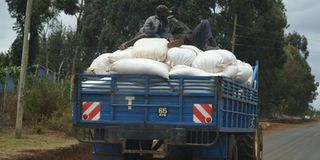Kebs raises concern on high levels of aflatoxin in maize

What you need to know:
- The complaints come even as processors experience acute shortage of the produce.
- Many millers in western Kenya are getting maize from schools and other learning institutions.
- The institutions began selling their stocks when the Ministry of Education cancelled the school academic calendar.
The Kenya Bureau of Standards (Kebs) and consumers have raised concern on high levels of aflatoxin in maize, the staple food for most Kenyan households.
The complaints come even as processors experience acute shortage of the produce.
The millers say their stocks were exhausted two months to the harvest of this season’s crop in the North Rift, the country’s grain basket.
Many millers in western Kenya are getting maize from schools and other learning institutions that were closed in March to stop the spread of coronavirus.
The institutions began selling their stocks when the Ministry of Education cancelled the school academic calendar.
Local posho mill
Kebs MD Bernard Njiraini’s technical adviser Martin Masibo said poor storage and heavy rains in most maize-growing zones are contributing to high aflatoxin levels in the grains.
“We carry out regular inspection and tests for aflatoxin to ensure that flour and other products meet recommended standards. Unfortunately, some unscrupulous companies flout the laid-down guidelines,” Mr Masibo said.
He added that teams made up of public health officials are carrying out market surveillance to crack down on firms and individuals selling contaminated flour.
Aflatoxin level
Allowable aflatoxin level in maize in Kenya is 10 parts per billion. Anything level above that is considered to be contamination.
“There have been complaints about contaminated flour but our teams acted fast and pulled the products from the market. Licences of such firms have been cancelled,” Mr Masibo said.
He added that State agencies and other stakeholders, including retail outlets and consumers, are expected to properly store food and check aflatoxin levels.
“Millers should ensure maize is safe for consumption before buying,” Mr Masibo added.
Acute shortage
Processors operating under the Grain Belt Millers Association (GBMA) Wednesday decried the acute maize shortage after harvests declined from 44 million to 33 million bags.
“We are operating at 30 per cent capacity due to the low supply of maize,” GBMA chairman Kipngetich Mutai said.
The association is made up of more than 35 small-scale millers.
It has asked the government to review acceptable aflatoxin levels from 10 to 20 parts per billion.
“Most milling firms risk closure because Kebs introduced stringent aflatoxin measures,” Mr Mutai said.
He added that maize from Meru, Ukambani and western Kenya – except Uasin Gishu and parts of Trans Nzoia counties – has high aflatoxin level.
Contaminated
“Though there is some maize in the market, we cannot process it as it is contaminated. Unfortunately, such maize ends up at the local posho mill,” Mr Mutai said.
He added that every miller has bought machines for testing aflatoxin valued at Sh1 million as part of conditions set by Kebs to guarantee quality flour.
Aflatoxin is produced by a fungus that grows on maize, groundnuts and several other crops.
Cancer
Consuming high levels of aflatoxin can be fatal and exposure has been linked to liver cancer, suppressed immune response and stunted growth.
Kenya has among the highest rates of aflatoxin exposure in the world.
Kebs suspended 17 maize flour brands last year, saying they contained high levels of aflatoxin.
Kenya Agricultural and Livestock Research Organisation director general Eliud Kiplimo Kireger says Kenya’s food problems are compounded by the fact that the aflatoxin is in the soil.
“It is all over the country. We have not understood why it is high in some areas,” he said.






